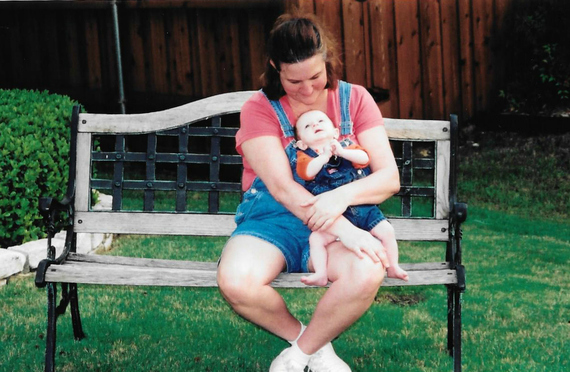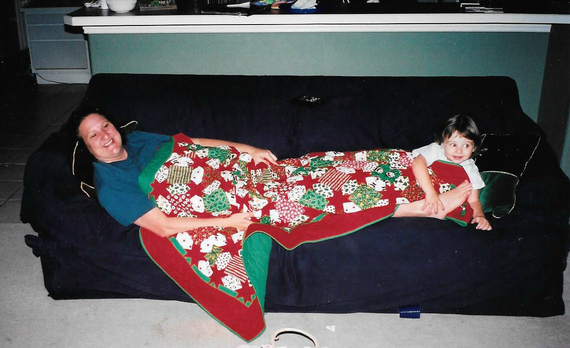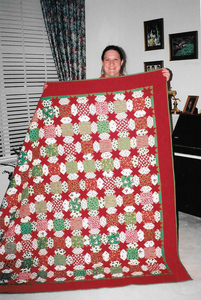 The bright green and red, king-sized Christmas quilt could be anywhere in the Schaeffer house right now. While most of their holiday decorations are seasonal, this blanket is the lone exception, always on the move from a sofa to a bed or any other favorite hangout.
The bright green and red, king-sized Christmas quilt could be anywhere in the Schaeffer house right now. While most of their holiday decorations are seasonal, this blanket is the lone exception, always on the move from a sofa to a bed or any other favorite hangout.
Everyone loves nuzzling under it -- mainly because of how cozy it is, partly because of what it represents.
Jenn Schaeffer started making the quilt around Christmas in 2001. It was a major undertaking (nearly 2,000 pieces), begun at a hectic time: Her oldest child, Julia, was 1, and Jenn was pregnant with another daughter, Laura.
Laura arrived before the quilt was finished. Then Jenn was in such a rush to finish that she let a neighbor help.
Why the hurry?
Doctors told Jenn she had heart failure. They expected her heart to stop beating within a year.
So in addition to raising two babies and helping her husband prepare to raise them without her, Jenn added a few more things to her to-do list.
The first was finishing the quilt. Despite her little energy she had, it meant everything for her to have something handmade from her to the girls.
She also set aside something special for each to receive long after she'd be gone.
***
Jenn's first pregnancy and delivery went perfect. Things were going just fine the second time as she prepared for Laura to arrive in February 2002.
On Dec. 21, 2001, Jenn had a funny feeling in her upper chest. Bronchitis, her family physician said. So she went back home and kept working on the quilt.
On Christmas Eve, Jenn was on the phone with her sister, breathing so heavily that she could barely get the words out. Her sister thought Jenn was doing something strenuous. Holding the phone was the extent of her efforts.
Jenn went to a hospital in their north Dallas suburb, and it was a good thing she did. A doctor said that without intervention, Laura likely would've died the next day and Jenn the day after.
Still, there was only so much doctors could do.
They feared that Laura was too compromised to survive a C-section. They also feared that Jenn was too compromised to survive natural childbirth.
***
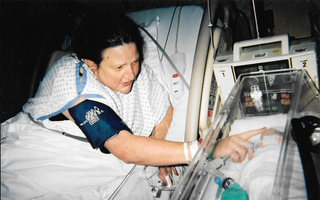 A doctor manipulated Laura's heart during labor, essentially giving compressions as the baby was being delivered. She made it, and was sent to the neonatal intensive care unit to recover. She wouldn't feel her mother's touch for six days.
A doctor manipulated Laura's heart during labor, essentially giving compressions as the baby was being delivered. She made it, and was sent to the neonatal intensive care unit to recover. She wouldn't feel her mother's touch for six days.
Jenn spent a total of 11 days in intensive care.
A major concern was her "ejection fraction," a measurement of how much blood was being pumped from her heart's left ventricle. A healthy person's ejection fraction is between 55 percent and 70 percent; Jenn was at 20 percent.
Finally, doctors pinpointed the source of her problem: Dilated cardiomyopathy. Her heart muscle had stretched and thinned, causing the inside of the chamber to expand. The muscle could no longer contract properly, which meant it couldn't pump her blood very well.
Once Jenn was stable enough to go home, doctors discharged her with little hope. The best they could do was suggest how to leave a lasting impact on her daughters' lives, such as finishing that quilt and writing letters for her daughters to eventually read.
Jenn controlled her emotions long enough to write two letters. Each was handwritten, each about eight pages, front and back.
There were some similarities in the two notes -- how much she loved each girl, hopes for their future, stories about her own life. There were differences, too. Because Julia was older, Jenn included more details about the kind of person she expected her to become. Laura's note included details about the journey they'd shared together and how that connected them.
Jenn tucked the letters into each girl's special trunk, a time capsule of sorts that holds their baby books, a Bible with their newborn handprints and footprints on the inside cover and other timeless treasures. She told her husband, Bob, to present the letters to each girl on her 16th birthday.
***
Things continued downward for Jenn, such as a bout of kidney failure and a minor heart attack.
Then a neighbor offered a suggestion. Go see another cardiologist, Clyde Yancy.
Whereas writing the letters had been Jenn's emotional low point, meeting Dr. Yancy would be the start of her turnaround.
He knew exactly how to handle her case, formulating a plan as they spoke. His confident demeanor filled her with hope.
That whole notion of one year to live? Forget about it. She'd live at least 10.
In fact, his emphasis was on how she wanted to live.
If she did a pretty good job of following his advice, she'd be healthy enough to sit in her car and watch her daughters compete in sports.
If she closely followed his advice, she could be on the sideline with them, whooping and hollering.
"Everything out of his mouth made me feel, 'This is different,'" Jenn said. "It was such a relief."
***
It took about a year to get her medicines right, and there were ups and downs along the way.
Every bit of progress reinforced her hope and her confidence in Dr. Yancy.
He stoked those fires by talking about her daughters' future -- and her being there for it.
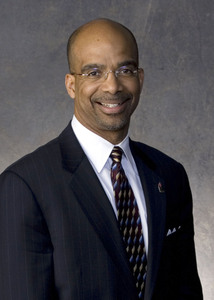 This is a good time to tell you a little more about Dr. Yancy, one of the most dynamic people I know.
This is a good time to tell you a little more about Dr. Yancy, one of the most dynamic people I know.
In addition to being a brilliant physician, he's been a vital part of the American Heart Association. He was our national president in 2009-10; he helped write our 2020 Impact Goal (to improve the cardiovascular health of all Americans by 20 percent while reducing deaths from cardiovascular diseases and stroke by 20 percent, all by 2020); and he played a vital role in developing a key ingredient to reaching this target -- "Life's Simple Seven," the key measures and behaviors people can follow to improve their health. Last summer, he received the AHA's highest honor for a volunteer, the Gold Heart Award.
He's also a wonderful person, and a devoted dad to a pair of daughters. In the Schaeffer family, he saw outlines of his own, and he didn't want those girls to be without their mom.
***
Jenn indeed followed Dr. Yancy's advice, and the results have been as spectacular as he predicted. Her ejection fraction rate is back up to 40 percent, which she calls "amazing."
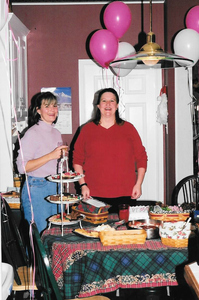 She's fully appreciated watching Julia blossom into a studious bookworm ("Every Christmas she asks for 200 books!"), and seeing Laura become an extrovert, someone Jenn describes as a "Here I am, world!" type of person.
She's fully appreciated watching Julia blossom into a studious bookworm ("Every Christmas she asks for 200 books!"), and seeing Laura become an extrovert, someone Jenn describes as a "Here I am, world!" type of person.
"It's so shocking they're sisters because they're such opposites," Jenn said, laughing. "But they like to do things together."
Both played sports, and Jenn indeed was a cheerleader on the sideline.
"I'll stand there and be watching and I'll realize, 'I'm watching my daughter play a sport!' Even this past year, Laura was playing volleyball and golf and I thought, 'I can't believe I'm doing what Dr. Yancy said I'll be doing!'" Jenn said. "It's such an incredible feeling to do it and to know I'm going to keep doing it, next year and the year after."
This Thanksgiving, both girls are going to be in the Macy's Thanksgiving Day parade in New York City.
"Their drill team made it, and I'll get to see it," Jenn said.
While the girls have a 50 percent chance of inheriting their mom's condition, both are very healthy. Laura is 13.5 and has no lingering issues from her frightening birth.
She wants to become a veterinarian, or another type of doctor. It makes sense, then, that science is among her favorite subjects. And when she had to do a project for the Health Fair this past school year, she chose to focus on heart failure.
She also enlisted Dr. Yancy's help.
***
Although he'd long since left Dallas -- becoming chief of cardiology at Northwestern University Feinberg School of Medicine in Chicago -- she sent him an email.
After asking if he remembered their family (he did, of course), Laura thanked him for having given her the best gift: her mom. Now she had another favor: Could he videotape a brief message to her class about heart failure?
The next day, he hired a video crew.
***
Heart failure is increasing in America, and the AHA is responding by building an even stronger portfolio of offerings.
Last week, we released results of a survey that showed there are still misconceptions about the disease: 58 percent of those surveyed incorrectly referred to heart failure as a natural cause of death that occurs when the heart stops beating; 46 percent incorrectly said heart failure is a silent killer with no symptoms.
Heart failure actually occurs when the heart can't pump blood efficiently enough to meet the body's needs. It results from the added stress of health conditions that either damage the heart or make it work too hard.
There is no cure, but it can be managed, as Jenn's story shows. Early diagnosis is crucial, and there are important symptoms to recognize, such as difficulty breathing (Jenn's key symptom), fatigue and swelling of the feet, ankles and legs.
One in five Americans over age 40 will be diagnosed with heart failure. Approximately 50 percent of people diagnosed with heart failure could die within five years -- a prognosis worse than most cancers.
Look for an awareness campaign about heart failure later in this year. Jenn, Laura and Julia are featured in one of the videos.
***
Being on the sidelines is the perfect symbol of how Jenn took advantage of her second chance at life.
Another great piece of evidence is all the stamps on her passport.
She's taken the girls to 16 countries. In 2011, they took a cruise from Florida to Spain, then drove across much of Europe.
"My daughters hang-glided off the Swiss Alps," she said. "I can't believe it now, because they were just like 10 and 11. But I like doing off-the-wall stuff. I've been given this gift of time and I want to make the most of it. I didn't think I'd get to see my youngest's first birthday, and now I have two teenagers! I know I'm going to see them graduate college, get married and have babies. That is such a gift that God and Dr. Yancy have given me. I've gotten to create memories with them that will never go away."
The mother-daughter bond Jenn has forged with each of her girls could fill a book. It sure beats the eight-page note she left them. Yet they are still there, still in those trunks stacked in the garage.
The girls have always known about the trunks. Each tends to get sentimental around her birthday, and about every few years, they ask to pull everything out of their personal time capsule. Along the way, they've read those letters, sobbing together through every line.
Julia turns 16 next year, and she's already asked Jenn to present the letter to her that day.
Here's hoping they read it together, snuggled under the Christmas quilt.
